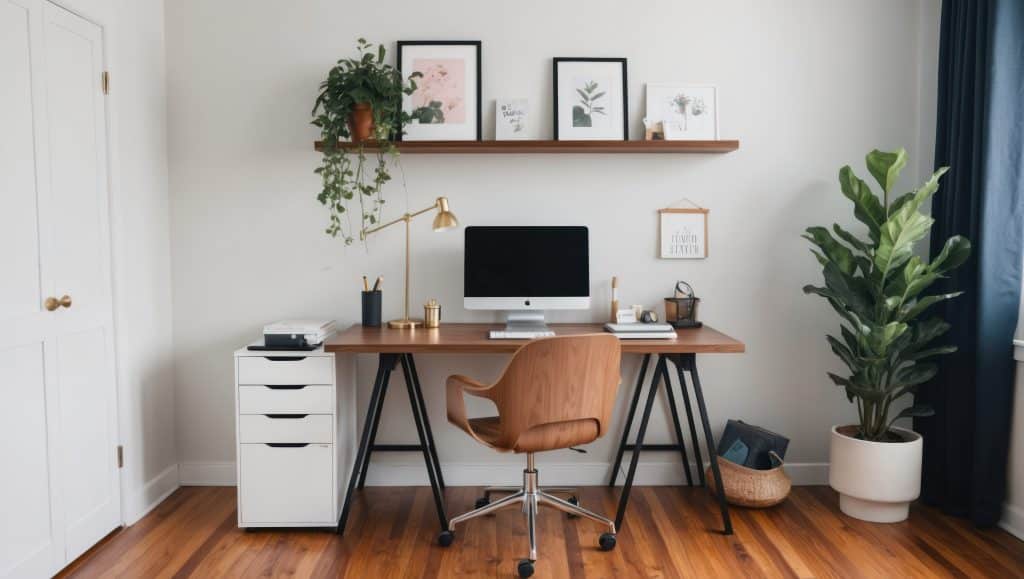How Americans Are Reshaping Home Life Post-Remote Work: From Smart Kitchens to Wellness Corners

Remote work wasn’t just about location—it redefined life at home. With kitchen-table offices, Zoom rooms, and side‑hustle garages, Americans reshaped their living spaces. Now in 2025, even hybrid schedules have cemented permanent changes in how we dwell, design, and connect.
These days, homes are dynamic—designed for work, wellness, leisure, and hospitality. This post unpacks the major forces driving home life’s reinvention, with real stats, expert insights, and design inspiration.
📊 Top Post-Remote Home Features (2025)

🏠 Hybrid Life, Hybrid Homes
Since the remote work wave began in 2020, American homes have become more than just places of rest—they’re now command centers for career, learning, and life. By 2025, the majority of workers in fields like tech, marketing, and education are still spending 2–3 days a week at home. According to Gallup’s 2025 workplace survey, 53% of U.S. employees currently work hybrid schedules.
The shift to hybrid hasn’t just affected routines—it’s deeply altered home layouts. The classic “home office” is being replaced by multi-purpose zones: kitchen nooks become Zoom stations; guest rooms double as podcast studios. Real estate developers have taken notice. Major builders like Lennar and D.R. Horton are offering floorplans with optional “flex rooms,” allowing buyers to choose how a space functions based on their needs.
In urban areas, where square footage is scarce, people are getting especially creative. Floating desks, fold-away walls, and mobile filing cabinets are popular among renters and condo owners. Some are even using smart partitions—like those from IKEA’s RÖRBO system—to divide spaces on demand. These solutions give residents the flexibility to pivot between productivity and relaxation with minimal disruption.
Meanwhile, suburban and rural homeowners are transforming basements and garages into semi-permanent workstations. According to the Houzz 2024 Home Renovation Trends Report, nearly 64% of home projects in the U.S. last year involved creating or updating a work-related space.
As the line between home and office continues to blur, Americans are placing a higher value on versatility. Whether it’s through modular design, mobile tech stations, or smart lighting tailored to work rhythms, the future of home life in America is about balancing focus with fluidity.

🛋️ The Rise of Multi-Functional Rooms
As more Americans continue to work and learn from home, the demand for multi-functional spaces has exploded. In 2025, the average household space must serve two or more purposes—especially in urban or multi-generational homes. A room that was once used solely for entertainment might now host yoga sessions in the morning, act as a home office in the afternoon, and serve as a family movie room by night.
Furniture brands have adapted quickly. Companies like West Elm and IKEA now offer extensive lines of flexible furniture, including lift-top coffee tables, wall-mounted folding desks, and daybeds with hidden storage. Even Murphy beds have made a major comeback.
A 2024 Zillow housing study reported that listings featuring rooms described as “convertible,” “studio-friendly,” or “multi-purpose” saw a 10–14% increase in clicks and faster sales turnaround in competitive metro areas like Austin, Denver, and Raleigh.
One popular trend is the integration of sliding barn doors or pocket doors to quickly create privacy within shared spaces. Another is “furniture zoning,” where rugs, lighting, and modular pieces help visually divide open-concept layouts into functional workstations, dining spots, and lounge areas—without construction.
Case in point: A family in Seattle redesigned their 300-square-foot basement into a three-zone room. By day, it acts as a quiet Zoom zone for remote work and tutoring. By evening, the space converts into a home gym and meditation area with simple lighting changes and moveable equipment. This kind of ingenuity is what’s driving the future of domestic design.
It’s not just about saving space—it’s about aligning your home with your evolving lifestyle. Multi-functional rooms are an answer to the question: how can we live smarter, not larger?
🧘♀️ Wellness Corners & Mental Health Nooks

Mental health isn’t a trend—it’s a new baseline. Following the emotional toll of the pandemic years, Americans have begun intentionally carving out spaces in their homes dedicated to psychological well-being. These “wellness corners” are not just aesthetic—they serve as grounding zones for decompression, mindfulness, and recovery.
According to Pinterest’s 2025 Predictions, searches for “indoor zen corners” and “meditation nooks” surged by over 200% in the past year. The platform also notes that Gen Z is leading the way, combining aesthetics with healing functionality by including plants, light therapy lamps, and soundscapes in their decor.
Interior designers are responding. Many are now certified in wellness-centered design or biophilic principles—design practices that promote a closer connection with nature. Design firms like Clayton Homes are incorporating biophilic elements like living walls, reclaimed wood, and soft-tone LED lights into client spaces.
For families, wellness corners can include emotion-focused features for children: think plush rugs, cozy reading tents, calming color palettes, and fidget tools that double as decor. These “micro-sanctuaries” support both sensory development and mental regulation in busy home environments.
Adults are leaning into aroma diffusers, Himalayan salt lamps, indoor water fountains, and intentional lighting design. A growing number of Americans are even investing in full-on “recharge rooms,” which use adjustable LEDs and soothing sound machines to simulate spas or wellness retreats.
In a 2024 Medium article on wellness design, experts confirmed that simple environmental changes—like incorporating natural materials and proper air circulation—can improve sleep, reduce anxiety, and enhance productivity.
The key takeaway? In 2025, a calm home is no longer a luxury—it’s a lifestyle requirement. These small yet powerful design shifts reflect a larger cultural movement toward self-care and emotional resilience at home.
📱 Smart Tech Meets Slow Living
The smart home revolution is no longer about flashy gadgets—it’s about creating environments that support intentional living. In 2025, Americans are using technology to reduce decision fatigue, encourage mindfulness, and design calmer routines.
According to a 2025 Statista report, over 68% of U.S. households now use at least three smart home devices daily. But instead of using tech to do more, many are using it to slow down. Think circadian rhythm lighting systems, smart thermostats that optimize energy use based on your daily flow, or voice assistants that lead you through guided meditations.
Calm technology—a term coined by Xerox PARC—emphasizes tech that “informs but doesn’t demand attention.” This philosophy is visible in products like Philips Hue light bulbs (which adjust color temperature based on time of day), Google Nest smart thermostats, and even smart aromatherapy diffusers that sync with your calendar and stress level.
Platforms like Headspace and Calm are now integrated with home speakers like the Amazon Echo and Google Nest Audio. You can say, “Start my wind-down routine,” and have your lights dim, ambient music play, and lavender scents activate—without lifting a finger.
A 2024 survey by American Home Shield found that 82% of homeowners using smart devices say the technology has improved their daily mental health. Most cited benefits like better sleep, fewer distractions, and increased comfort.
Tech is also aiding in habit-building. Smart fridges recommend recipes based on expiring ingredients to reduce waste. Smart mirrors offer real-time posture correction during workouts or yoga. Even robot vacuums now sync with your weekly schedule and avoid specific “quiet zones.”
The future of the American home isn’t about tech for tech’s sake—it’s about balance, intention, and designing rhythms that support human well-being. By combining automation with awareness, Americans are turning their homes into smart sanctuaries.
🌳 Community, Privacy & The New American Neighborhood

One of the most surprising outcomes of remote work has been the renewed importance of local community. In a time where people left cities for more space—or spent more time at home in tight urban quarters—many Americans began reevaluating how they connect with neighbors.
The co-housing movement has gained momentum. These are intentional neighborhoods where private homes share common amenities like kitchens, gardens, and gathering spaces. According to a 2025 article from The Guardian, co-housing offers seniors and solo dwellers a greater sense of belonging, with shared responsibilities and community rituals built in.
In the U.S., co-housing projects are popping up from Portland to Asheville. The Cohousing Association of the United States tracks more than 180 active communities nationwide. These spaces are not just for aging in place—they also appeal to Millennials and Gen Z adults seeking deeper connections in a digital age.
Zoning changes and policy updates have made it easier to build accessory dwelling units (ADUs), backyard tiny homes, or convert garages into livable spaces. According to a 2024 Vox report, this shift is part of the broader “Yes In My Backyard” (YIMBY) movement, which pushes for more flexible, affordable housing in traditionally suburban or exclusionary zones.
Another growing trend? The revival of “porch culture.” As people spend more time at home, they’re investing in their front yards as social spaces. Mini-library boxes, neighborhood gardens, and even shared dog parks are sprouting up in suburban developments. These small touches foster organic connections—especially for families with kids or pet owners.
On the flip side, privacy still matters. Many homeowners are also installing noise-dampening fences, privacy landscaping (like vertical garden walls), or creating “quiet zones” within homes where solitude and stillness are respected.
Ultimately, post-remote life has reshaped how Americans view home and neighborhood. The dream is no longer a white picket fence and two-car garage—it’s a flexible, connected, and supportive community that balances togetherness with autonomy.
🔚 Final Thoughts: Home Isn’t What It Used to Be
The evolution of American home life post-remote work reveals more than just design trends—it shows a cultural shift. Americans are rethinking space, routine, connection, and rest. What used to be a place of rest and privacy is now a multifunctional, emotionally intelligent, and tech-enhanced sanctuary.
Whether it’s through wellness corners, hybrid-use furniture, community-forward neighborhoods, or smart tech with intention, the common thread is adaptability. This new era of living prioritizes values: mental health, connection, flexibility, and sustainability.
As the line between work and life continues to blur, our homes are becoming more than shelters—they’re living ecosystems built to support a balanced future.
✨ In Summary:
- Smart tech is being used to promote slow living, not just automation.
- Wellness corners and mental health nooks are now mainstream design choices.
- Multi-functional rooms are optimizing space in modern homes.
- Community living and co-housing are offering new forms of social connection.
- Flexibility is the new gold standard of home design.





